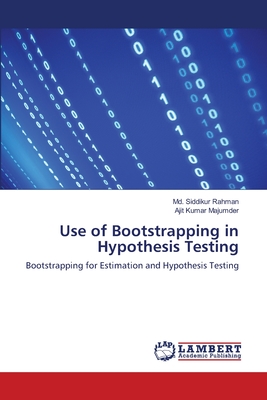
Use of Bootstrapping in Hypothesis Testing
Paperback
Currently unavailable to order
Please enter your email and a message will be sent to you when this product becomes available on our website.
ISBN13: 9783659501685
Publisher: Lap Lambert Academic Pub
Published: Dec 13 2013
Pages: 160
Weight: 0.54
Height: 0.37 Width: 6.00 Depth: 9.00
Language: English
Also in
General Mathematics
Six Easy Pieces: Essentials of Physics Explained by Its Most Brilliant Teacher
Sands, Matthew
Feynman, Richard P.
Leighton, Robert B.
Paperback
The Secret Lives of Numbers: A Hidden History of Math's Unsung Trailblazers
Revell, Timothy
Kitagawa, Kate
Hardcover
Oliver Byrne's Elements of Euclid: The First Six Books with Coloured Diagrams and Symbols
Art Meets Science
Hardcover
Hidden Figures: The American Dream and the Untold Story of the Black Women Mathematicians Who Helped Win the Space Race
Shetterly, Margot Lee
Paperback
Counting with - Contando Con Frida: A Bilingual Counting Book
Stein, Ariana
Rodriguez, Patty
Hardcover
Do Plants Know Math?: Unwinding the Story of Plant Spirals, from Leonardo Da Vinci to Now
Douady, Stéphane
Golé, Christophe
Dumais, Jacques
Hardcover
Math Games with Bad Drawings: 75 1/4 Simple, Challenging, Go-Anywhere Games--And Why They Matter
Orlin, Ben
Hardcover
Vector: A Surprising Story of Space, Time, and Mathematical Transformation
Arianrhod, Robyn
Hardcover
Mathematics: An Illustrated History of Numbers (100 Ponderables) Revised and Updated
Jackson, Tom
Hardcover
Waves in an Impossible Sea: How Everyday Life Emerges from the Cosmic Ocean
Strassler, Matt
Hardcover
Hidden Figures: The American Dream and the Untold Story of the Black Women Mathematicians Who Helped Win the Space Race
Shetterly, Margot Lee
Paperback
Sudoku for Brain Fitness: 90-Day Challenge to Sharpen the Mind and Strengthen Cognitive Skills
Clontz, Steven
Demyanovich, Julie
Paperback
A Mind for Numbers: How to Excel at Math and Science (Even If You Flunked Algebra)
Oakley, Barbara
Paperback
The Art of Strategy: A Game Theorist's Guide to Success in Business and Life
Dixit, Avinash K.
Nalebuff, Barry J.
Paperback
Touchthinklearn: Numbers: (Board Books for Baby Learners, Touch Feel Books for Children)
Deneux, Xavier
Hardcover
Hidden Figures: The American Dream and the Untold Story of the Black Women Mathematicians Who Helped Win the Space Race
Shetterly, Margot Lee
Hardcover
Quadrivium: The Four Classical Liberal Arts of Number, Geometry, Music, & Cosmology
Sutton, Daud
Lundy, Miranda
Ashton, Anthony
Hardcover
50 Math Tricks That Will Change Your Life: Mentally Solve the Impossible in Seconds
Zakowich, Tanya
Paperback
SAT Math Workbook: Up-To-Date Practice for the Digital Exam
Barron's Educational Series
Leff, Lawrence S.
Paperback
Math Fundamentals 3 - Geometry: A Quickstudy Laminated Reference Guide
Warren, Peggy
Wright, Susan
Expolog LLC
Other
Schaum's Outline of Mathematical Handbook of Formulas and Tables
Liu, John
Spiegel, Murray R.
Lipschutz, Seymour
Paperback
Math Makers: The Lives and Works of 50 Famous Mathematicians
Spreitzer, Christian
Posamentier, Alfred S.
Hardcover
Productive Math Struggle: A 6-Point Action Plan for Fostering Perseverance
Sangiovanni, John J.
Dykema, Kevin J.
Katt, Susie
Paperback
Sciencia: Mathematics, Physics, Chemistry, Biology, and Astronomy for All
Tweed, Matt
Watkins, Matthew
Betts, Moff
Hardcover
Building Thinking Classrooms in Mathematics, Grades K-12: 14 Teaching Practices for Enhancing Learning
Liljedahl, Peter
Paperback
Math Practice Workbook Grades 6-8: 1000+ Questions You Need to Kill in Middle School by Brain Hunter Prep
Brain Hunter Prep
Paperback
Mathematical Methods for Physics and Engineering: A Comprehensive Guide
Hobson, M. P.
Bence, S. J.
Riley, K. F.
Paperback
SAT Level Up! Math: 300+ Easy, Medium, and Hard Drill Questions for Scoring Success on the Digital SAT
The Princeton Review
Paperback
Making Democracy Count: How Mathematics Improves Voting, Electoral Maps, and Representation
Volic, Ismar
Hardcover
Machine Learning with PyTorch and Scikit-Learn: Develop machine learning and deep learning models with Python
Liu, Yuxi (Hayden)
Raschka, Sebastian
Paperback
Serious Cryptography, 2nd Edition: A Practical Introduction to Modern Encryption
Aumasson, Jean-Philippe
Paperback
The Mathematics Playbook: Implementing What Works Best in the Classroom
Thunder, Kateri
Shin, Michelle
Almarode, John T.
Paperback
Origami Polyhedra for Beginners: Amazing Geometric Paper Models from a Leading Japanese Expert!
Kawamura, Miyuki
Paperback
Creation, Separation, and the Mind - The Three Towers of Singularity: The Application of Universal Code in Reality
Schwarzer, Norbert
Wismann, William E.
Martin, David E.
Hardcover
GED Math Practice Workbook: The Most Comprehensive Review for the Math Section of the GED Test
Nazari, Reza
Paperback
Elementary and Middle School Mathematics: Teaching Developmentally
Bay-Williams, Jennifer
Van de Walle, John
Karp, Karen
Paperback
STEM Study Habits: Successfully Navigate Math, Science, Engineering, and Life for Your Degree
Borglum, Scyller
Paperback
Nonstandard Notebook: Mathematically Ruled Pages for Unruly Thoughts
Langville, Amy
Chartier, Tim
Paperback
Secrets of Mental Math: The Mathemagician's Guide to Lightning Calculation and Amazing Math Tricks
Benjamin, Arthur
Shermer, Michael
Paperback
Concrete Mathematics: A Foundation for Computer Science
Knuth, Donald
Graham, Ronald
Patashnik, Oren
Hardcover
Visible Learning for Mathematics, Grades K-12: What Works Best to Optimize Student Learning
Frey, Nancy
Hattie, John
Fisher, Douglas
Paperback
The Principia: The Authoritative Translation: Mathematical Principles of Natural Philosophy
Newton, Isaac
Paperback
GED Math Test Tutor, for the 2024-2025 GED Test: All the Tools You Need to Succeed
Rush, Sandra
Paperback
Math Fundamentals 1 - Number Sense & Operations: A Quickstudy Laminated Reference Guide
Warren, Peggy
Wright, Susan
LLC
Other
The 125 Best Brain Teasers of All Time: A Mind-Blowing Challenge of Math, Logic, and Wordplay
Danesi, Marcel
Paperback
The Beginner's Guide to Constructing the Universe: The Mathematical Archetypes of Nature, Art, and Science
Schneider, Michael S.
Paperback
Shape: The Hidden Geometry of Information, Biology, Strategy, Democracy, and Everything Else
Ellenberg, Jordan
Paperback
Who Gets What -- And Why: The New Economics of Matchmaking and Market Design
Roth, Alvin E.
Paperback
Beautiful Math: The Surprisingly Simple Ideas Behind the Digital Revolution in How We Live, Work, and Communicate
Bernhardt, Chris
Hardcover
Beyond Measure: The Hidden History of Measurement from Cubits to Quantum Constants
Vincent, James
Paperback
Theory of Games and Economic Behavior (Large Print Edition)
Neumann, John Von
Morgenstern, Oskar
Hardcover
Cybernetics: Or the Control and Communication in the Animal and the Machine
Wiener, Norbert
Paperback


 Sign-In
Sign-In Cart
Cart